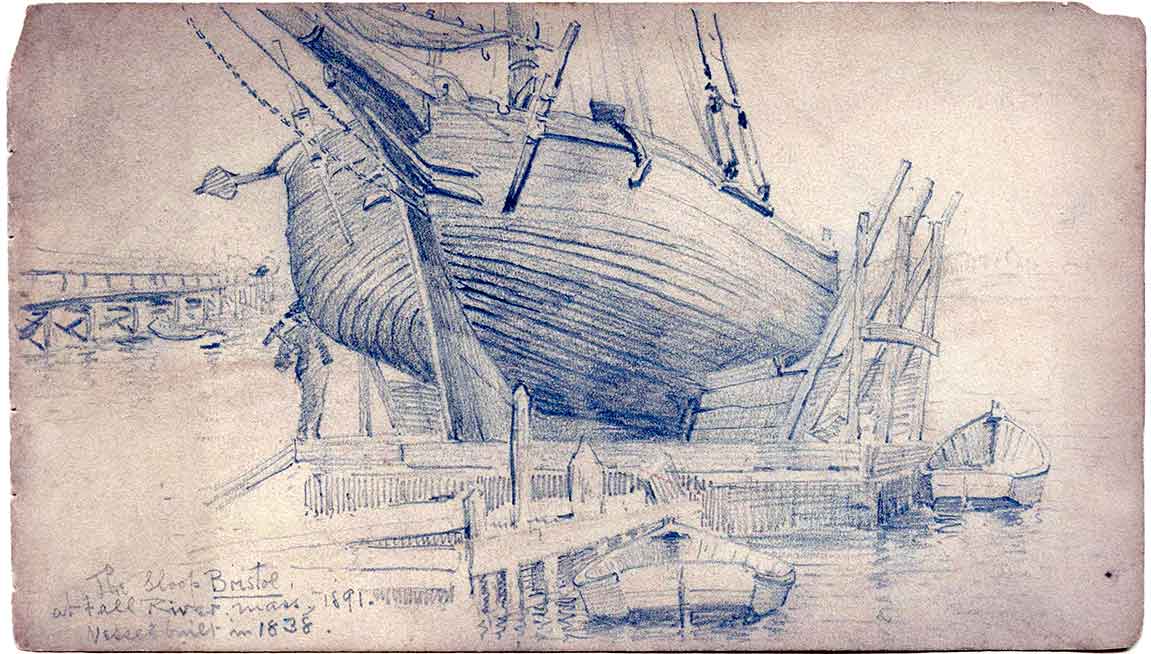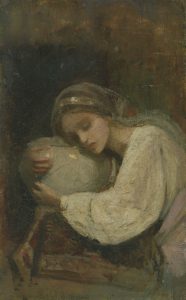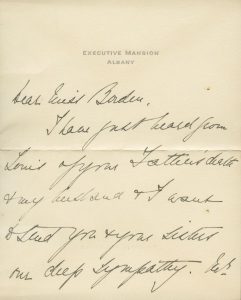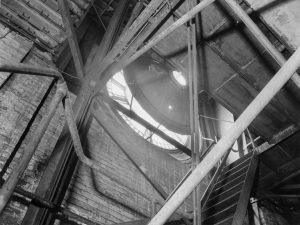Recent Acquisitions
Each year, the FRHS acquires new material for its collections through gift or purchase.
The FRHS’s commitment to acquiring material that broadens the scope of its collections is supported by our Acquisition Fund, philanthropic foundations, and the generosity of private donors, who have identified FRHS as the ideal home for their objects, ensuring their study, research, and exhibition.
These new acquisitions enhance our holdings in various categories, and ensure the development of a collection representative of Fall River’s multi-cultural history.
The following highlights represent a fraction of our recent acquisitions; additional items are regularly added to our website, so check this space often to discover some of our latest additions.
The Sloop Bristol at Fall River, Mass.
 James William Pattison (1843-1915)
James William Pattison (1843-1915)
Graphite on paper.
W. 20.0 cm (7 ⅞ in.); H. 11.4 cm (4 ½ in.)
1891
FRHS purchase, made possible by donors to the Acquisition Fund.
Collection: Paintings, Drawings, and Sculpture – 19th Century
About the object:
This drawing of the Sloop Bristol was originally contained in a sketchbook by James William Pattison (1843-1915) that was one of a group of sketchbooks by the artist offered at auction in 2007. Purchased by a dealer, the sketchbooks were, unfortunately, disassembled, with the pages removed from their original binding; the drawings were subsequently reoffered for sale on an individual basis, at which time this piece came to the attention of the FRHS.
The Sloop Bristol was built in Freetown, Massachusetts, in 1838, and was registered in the port of Fall River; at 29.33 tons, she was 52.3’ long, and 19.4’ in breadth. Perhaps Pattison, en route via the Fall River Line to New York, Boston, or coastal New England, where he frequently summered, passed the waiting time wandering the Fall River waterfront, sketchbook in hand, where he captured this likeness of the Sloop Bristol in dry-dock.
This is the only know image of the vessel.
About the artist:
James William Pattison was born in Boston, Massachusetts. He was a veteran of the Civil War and his intricate sketches of the conflict were published in Harper’s Weekly. By 1866, he had settled in New York City, where he studied landscape painting with several eminent painters, including: either Sanford Robinson Gifford (1823-1880) or Robert Swain Gifford (1840-1905); William Hart (1823-1894); James McDougal Hart (1823-1901); and George Inness (1825-1894). This expert tutelage served him well.
He taught art instruction at Washington University in St. Louis, Missouri, for five years, after which he continued his art studies in Dusseldorf, Germany. By 1876, he had settled in Paris, where his work was represented in the Salon exhibitions from 1878 to 1881.
Returning to New York, he exhibited at the National Academy of Design and other prestigious galleries, and eventually accepted the position of director of the School of Arts in Jacksonville, Illinois. In 1896, he relocated to Chicago to lecture at the Art Institute, and taught at Rockford College, also in Illinois. He relocated to Ashville, North Carolina, in 1912.
His output included landscapes, marine paintings, animal studies in oil and watercolor, and etchings, which he exhibited nationally until late in his career. He was equally prominent as an art critic and a writer on art, with books and articles published worldwide.
Study for Isabella
 Mary Lizzie Macomber (1861-1916)
Mary Lizzie Macomber (1861-1916)
Oil on Academy board
W. 16.5 cm (6 ½ in.); H. 24.1 cm (9 ½ in.)
Circa 1908
FRHS purchase, made possible by donors to the Acquisition Fund.
Collection: Paintings, Drawings, and Sculpture – 19th Century
About the object:
This gem-like piece is a study for Mary Lizzie Macomber’s 1908 painting, Isabella; the finished work is currently in the collection of the Museum of Fine Arts Boston. It surfaced at a Connecticut auction in the 1980s at which time it was purchased by a European art dealer employed by a New York City gallery; the painting was subsequently taken to England, where it remained in that individual’s personal collection until being acquired by the FRHS.
The inspiration for Isabella was the tragic, sixty-two stanza poem, Isabella: or The Pot of Basil, written in 1818 by the British poet, John Keats (1795-1821).
The poem tells the tale of two, ill-fated young lovers, Isabella and Lorenzo; captivated by one another, they long to bask in each other’s affection. However, Isabella’s proud, ignorant brothers do not approve of the relationship, and, preferring that she become betrothed to a wealthy landowner, conspire to persuade the lovers to end their relationship. After several failed attempts, the brothers decide that only death will terminate the courtship, and thus they plot Lorenzo’s demise.
Lorenzo is lured into the forest, where Isabella’s brothers murder him and dispose of his remains. In order to explain his absence, the brothers claim that Isabella’s lover has left to explore foreign lands, leaving her to dream of the day when he may return to her.
One night, heartbroken Isabella sees a vision of a filthy and deceased Lorenzo; the apparition tells her where to unearth his remains. Isabella travels to the forest and proceeds to disinter the decaying corpse of her lover. In a fit of anguish, she removes Lorenzo’s head and brings the precious relic home where she wraps it in a silk scarf, tenderly burying it in a pot of fragrant basil; a flood of tears, the outpouring of her grief, provide water for the plant.
Curious about Isabella’s devotion to her pot of basil, her vile brothers steal it; breaking open the container they are horrified to discover Lorenzo’s decaying head. Fearful they will be found murderers, they dispose of the evidence and quickly flee Florence.
Tragically, Isabella spends the rest of her days wasting away, begging all if they have seen her beloved pot of basil.
About the artist:
A native of Fall River, Mary Lizzie Macomber (1861-1916) achieved renown during her time as a painter of idealized decorative and allegorical paintings in the Pre-Raphaelite style, which had developed in England, with artists working in the style of the early Renaissance painters.
Born of Pilgrim and Quaker stock, Mary was the daughter of a successful Fall River, Massachusetts, jeweler, Frederick Walter Macomber (1825-1886), who had hoped his sensitive daughter would become a poet; art was her chosen field. She studied with Robert Spear Dunning (1829-1905), the founder of the so-called Fall River School, in her native city for about three years, beginning circa 1880. Following her studies with Dunning, she entered the School of the Museum of Fine Arts, Boston, where she concentrated on figure painting. Ill health and bouts of depression, which plagued her throughout her life, prompted her leaving the museum school during her second year. She later resumed her studies in Boston, in the studio of Frank Duveneck (1848-1919), a prominent figure painter and portraitist. Following her studies, Mary opened her first Boston studio.
She was exhibiting by 1889, and rapidly achieved recognition for her brushwork and ingenious use of dramatic lighting. She was acclaimed, during her lifetime as “a mystic and a symbolist by nature,” and her paintings were often compared favorably to those of the illustrious artists, George Frederick Watts (1848-1919) and Elihu Vedder (1836-1923).
Throughout her career, Mary maintained studios in New York City and Boston, and exhibited her work at the most important exhibitions in the country; she was the recipient of numerous prestigious awards. Her obituary noted that, as a painter “of ideal and symbolized figures … she had attained a standard which was second to no other woman painter” in the United States.
Today, her works can be found in private collections and in major American and European museums. Study for Isabella is the first work by Macomber to enter the FRHS collection.
Holograph Letter, Signed, Enclosed in Holograph Envelope
 Letter:
Letter:
Eleanor Roosevelt (1884-1962), Executive Mansion, Albany, New York, to Bessey Borden (1874-1956), Fall River Massachusetts.
Wove paper, unidentified manufacturer; one sheet, single fold, inscribed in ink on three sides.
W. 12.4 cm (4 ⅞ in.); H. 15.6 cm (6 ⅛ in.)
January 24, 1930.
 Envelope:
Envelope:
Wove paper, unidentified manufacturer.
W. 12.70 cm x H. 15.56 cm (5” x 3 ⅛”)
Donor: Trintje Jansen
Collection: Manuscripts
Transcription:
I have just heard from Louis of your father’s death & my husband & I want to send you & your sisters our deep sympathy. Mr. Borden was such an interesting and dominating personality that I have often thought of him & of your kindness to me. It is sad when the generation ahead of us passes on, but I always think that for them it must been [sic] like great peace & was long awaited —
With warmest sympathy, believe me.
Very sincerely yours,
Eleanor RooseveltJan. 24th
About the object:
This interesting letter is contained in an archive of material pertaining to the family of Jerome Cook Borden (1845-1930), a prominent Fall River, Massachusetts, businessman and a member of one of the city’s oldest families. The archive directly descended in the Borden family until being donated to the FRHS.
Eleanor Roosevelt undoubtedly made the acquaintance of Jerome and his daughter, Bessey, through the auspices of his niece, and Bessey’s first-cousin, Grace (Hartley) Howe (1874-1955). Grace was the wife of Louis McHenry Howe (1871-1936), who Eleanor refers to in this letter as “Louis.”
A former newspaper reporter who was a very close friend and senior political advisor to Franklin Delano Roosevelt (1882-1945), Louis McHenry Howe was lauded as “The man who made Roosevelt.”
The Roosevelt and Howe families were intimately associated, so much so that Grace and her son, Hartley Edward Howe (1911-1996), were with the Roosevelts at their retreat at Campobello Island, New Brunswick, Canada, when Franklin was stricken with infantile paralysis; Grace immediately summoned her husband. Throughout Roosevelt’s long battle with the disease, Louis remained at Roosevelt’s side, acting as nurse and companion, winning the life-long respect and admiration of Eleanor, who considered him a “beloved friend.”
Eleanor, who credited Louis with mentoring her in public speaking, later said of him:
He was an old friend, a very close friend, who had lived so much of his life with us that he had a room in whatever house we happened to be in. He had rather few friends – people he cared for a great deal. And being a very delicate person, he had to concentrate on the few things he thought worth doing. He was a merciless critic of the people he felt responsibility for. When I first began public speaking, he would sit in the back of the hall and later tell me the mistakes I had made and what I ought to do to avoid repeating them.
He was one of those rare people who could tell a friend what he needed to know, yet temper it with kindness.
At the time of Louis’ death in Washington, DC, on April 18, 1936, President Roosevelt ordered that the flag on the White House, as well as those on all public buildings in the United States, be lowered to half-mast; for Howe, the nation would mourn.
His state funeral was held in the flower-banked east room of the White House, and was attended by prominent political figures and “great names of the nation.” During the solemn service, the visibly shaken President kept a steady gaze on the bronze casket containing the mortal remains of his truest friend and confidant. The First Family and their entourage followed the Howe family to Fall River to attend Louis’ burial in Oak Grove Cemetery, during which it was noted, “the President of the United States stifled a sob.”
Bell Tower
 George Wellington Potts
George Wellington Potts
Gelatin print on paper
W. 21.4 cm (8 7/16 in.); H. 16.2 cm (6 6/16 in.)
1950s
Donor: Geoffrey Wellington Potts
Collection: Photographs
About the object:
This photograph depicts the interior of the bell tower of the City Hall, Fall River, Massachusetts, showing the reverse of one of the four clock faces. The image is part of a large archive of glass plate negatives, gelatin prints, sheet film negatives, and slides, taken by Fall River Herald News photographer George Wellington Potts, and dating from the 1930s to the 1970s.
The collection also includes a selection of images taken by his mentor Walter Whitman Coolidge Sr. (1892-1962), also a photographer for that newspaper. The images descended in the Potts family until being donated to the FRHS.
Donor: Geoffrey William Potts
About the photographer:
A Fall River, Massachusetts, native, George Wellington Potts (1916-1991) was noted as having had “the special ability to capture the flavor of the city [of his birth] in his photographs,” an accurate statement, indeed. His interest in photography began in his youth, when he constructed a darkroom in the cellar of his family’s residence, and experimented with glass plate negatives. While still a student at his native city’s B.M.C. Durfee High School, the fifteen-year-old boy secured employment at the Fall River Herald News, in 1931, working in the circulation department and filling in as a switchboard operator on the late afternoon shift; thus began a career that would span fifty-one years.
He was hired, full-time, by the Herald News as backup to senior photographer, Walter Whitman Coolidge Sr. (1892-1962), who quickly became the young man’s mentor and close friend; the pair were dubbed “gruff Walt and gentleman George.”
Drafted in 1941, he served in the United States Army Air Corp as a photographer, first being sent to the Life Magazine School of Photography, and then to the Hal Roach Studios in Culver City, California, to study motion picture production. Serving in the First Combat Camera Unit, he was assigned to the 15th Air Force, and was deployed to Italy, Romania, and France, later being assigned personal photographer to Major General Nathan Farragut Twining (1897-1982), who commanded the 15th. He was released from service in 1945, by which time he had achieved the rank of 2nd Lieutenant. During his military career, he photographed and was associated with top brass and Hollywood legends, the latter including actors Alan Ladd (1913-1964) and George Montgomery (1916-2000); his commanding officer, and the man who signed his discharge papers, was Ronald Reagan (1911-2004).
Following his military discharge, he returned to Fall River and resumed employment at the Herald News, being named head of photography in 1955. He furthered his studies at Brown University in Providence, Rhode Island, and served on assignment for Life magazine. During his long tenure at the Herald News, it was estimated that he took in excess of 5000 photographs, an output that included “major fires, hurricanes and train wrecks, as well as political outings, society and glamour. His camera captured the likes of the legendary Mae West, as well as three presidents — John F. Kennedy, Harry S. Truman, and Dwight D. Eisenhower.”
His career witnessed countless changes in photography, and, as one of the leading “chroniclers of the city,” he was credited with directing the Herald News into “the new era of photography.”
Travel Guide
 The Index Guide to Travel and Art-Study in Europe
The Index Guide to Travel and Art-Study in Europe
By Dr. Lafayette Charles Loomis (1824-1905)
W. 11.4 cm (4 ½ in.); H. 17.1 cm (6 ¾ in.); D. 2.9 cm (1 ⅛ in.)
1888
The volume was the personal copy of Lizzie Andrew Borden (1860-1927).
Donor: Cara Warschaw Robertson
Collection: Lizzie Andrew Borden — Cara Warschaw Robertson Collection
About the object:
This travel guide was recently offered for sale by a Connecticut auction house from its own inventory, having been purchased by that firm for resale, and was acquired for the FRHS collection by Cara Warschaw Robertson. Provenance on the piece is currently being documented: It is believed to have been acquired by a Fall River, Massachusetts, family with strong personal ties to Lizzie A. Borden, from her residence, Maplecroft, shortly after her death in 1927. It remained in that family until being sold to a private collector, from whence it eventually made its way to the auction block.
When Lizzie purchased this travel guide, prior to her eighteen-week European tour in 1890, she acquired a concise, yet extremely well detailed volume; as was her usual habit, she inscribed the flyleaf “L. A. Borden” in her distinctive hand. Considerable thought undoubtedly went into her travel plans, and upon purchasing The Index Guide she selected a thoroughly modern, well-organized volume, arranged alphabetically for ease of use en route; she was not disappointed with her choice.
That she referenced the book extensively throughout her travels is evidenced by numerous annotations and marks — number signs, parenthesis, and underscoring — that she made to various entries in the text. Visiting the Cathedral of Our Lady in Antwerp, Belgium, for example, she wrote: “(Pulpit in Flemish Oak),” and, referencing the Resurrection of Christ, a 1611-1612 masterpiece, by the Flemish artist Peter Paul Rubens (1577-1640), noted: “Taken Away.” Touring the Dresdner Schloss, she was likely disappointed to find the Green Vaults, which house the largest collection of treasure in Europe, “Closed for 6 mos.”
Upon her return to Fall River, she would quote extensively from The Index Guide when assembling two albums of souvenir photographs, captioning many of the images she purchased abroad with informative passages selected from the guide, which she indicated in that volume by the use of parenthesis; the travel albums are currently in a private collection. One example accompanies a photograph of Rome’s Fontana Di Trevi, which she captioned: “In the centre is Neptune in a car drawn by horses and Tritons. It is a tradition that drinking at the fountain on departure from Rome insures the visitors return,” a verbatim quote from The Index Guide.
This highly important volume from Lizzie Borden’s private library provides considerable insight into her travel itinerary — especially as it contains numerous references to attractions not included in her travel albums — and offers rare, personal observations, made during her European Grand Tour.
About the author:
Dr. Lafayette Charles Loomis (1824-1905) was a distinguished educator, physician, author, editor, and a world-traveler; a noted expert on travel and art, he frequently lectured on those subjects.
His Index Guide was considered a cutting-edge travel guide in its day, lauded in The Penn Monthly, a contemporary publication, as a book that would “be extremely welcome” by those embarking on a European tour. The review noted that Loomis — referencing the most respected travel guides then in print — questioned “whether the fifteen volumes of Murray [Murray’s Handbooks] or the nine of Baedeker [Guides] required between Edinburgh and Naples could be reduced to one of companionable dimensions,” a query that prompted him to undertake the work.
The subsequent publication, The Index Guide to Travel and Art-Study in Europe, published by Charles Scribner’s Sons in New York City in 1882, was, indeed, extremely well received. It was small in size, comprehensive in scope, yet concise in content, and “arranged alphabetically,” which was “especially valuable for easy reference.”
Although the Baedeker Guides, in print from 1827 to 1948, continued to dominate the travel industry — they were universally referred to simply as Baedeker’s — Loomis’ work garnered its share of attention, and went into several editions.
